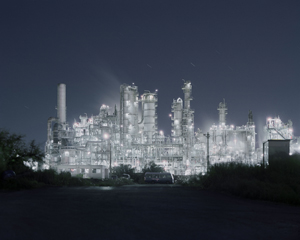
Alan Klotz Gallery 740 West End Avenue, Suite 52 NY 10025 New York États-Unis
Tetsugo Hyakutake, a Japanese citizen, has lived in the United States for the past six years studying photography and sharpening his eye for detail...incredible detail. Perhaps his time here has given him the perspective needed to concentrate his efforts on recording industrial landscapes in his native Japan during his frequent trips home. His eye may have been honed here, but his interest lies in what he refers to as the "Pathos and Irony" of Post WWII Industrial and economic development in Japan. During this time, Japan's need to overcome defeat and adversity brought about the embrace of progress and growth, perhaps at the expense of the reverence usually accorded to traditional societal values.
"I attempt to connect historical, economic, and social issues of post-war Japan with personal experiences and the voices of my generation. Despite the loss of human lives, destruction of its major cities, and its lack of raw materials, Japan became the second largest economy in the world in less than 30 years. Industrialization and economic development are often considered to be synonymous with the advancement of society. This is one 'unspoken truth' that I attempt to question by expressing the ironic duality of both the beauty and dehumanization inherent in industrialization."
The work itself is elegant, spare and ascetic; the prints luscious and the colors saturated. Their tonal richness seems, at first, to be at odds with the Spartan geometric simplicity of the subjects: it is only later that the higher, more complex intent of these images becomes apparent. While the artist is in fact arguing for the sheer beauty of his subjects (he wants us to love them as objects), the purity of line typically associated with objective architectural renderings remains. Though not of human scale, and devoid of human presence, these structures are of us...they are devices of collective unbridled ambition, pride and even greed. They display a combination of eerie isolation and engineered genius. They draw the viewer in to examine the flawless detail containing all of the mysterious mathematics of the contemporary world. Impressed upon the viewer is an almost otherworldly sensation-that of a sole trespasser in an unknown world. In the same powerful instant one witnesses a marvel and becomes vulnerable to subjugation by industrial conformity. These images suggest how we might live more harmoniously in a world of increasing alienation. We can choose to see the forms of industry as cold and forbidding, or we can see them as an image of the Emerald City glimmering in a future of wonders.

